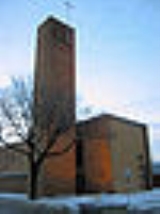
List of National Historic Landmarks in Minnesota
Encyclopedia
This is a complete List of National Historic Landmarks in Minnesota. The United States
National Historic Landmark
program is operated under the auspices of the National Park Service
, and recognizes structures, districts, objects, and similar resources according to a list of criteria of national significance. The state
of Minnesota
is home to 25 of these landmarks, illustrating the state's Native American
, industrial
, logging
, mining
, military
, and political heritage, as well as its contributions to the broader themes of developing the frontier
for the European pioneers.
The article also lists other historical landmarks of national importance that are administered by the National Park Service.
, a private, non-profit educational and cultural institution dedicated to preserving the history of the state of Minnesota
, owns and operates 26 museum
s and historic sites. Most, but not all of these are National Historic Landmarks or listed on the National Register of Historic Places
.
United States
The United States of America is a federal constitutional republic comprising fifty states and a federal district...
National Historic Landmark
National Historic Landmark
A National Historic Landmark is a building, site, structure, object, or district, that is officially recognized by the United States government for its historical significance...
program is operated under the auspices of the National Park Service
National Park Service
The National Park Service is the U.S. federal agency that manages all national parks, many national monuments, and other conservation and historical properties with various title designations...
, and recognizes structures, districts, objects, and similar resources according to a list of criteria of national significance. The state
U.S. state
A U.S. state is any one of the 50 federated states of the United States of America that share sovereignty with the federal government. Because of this shared sovereignty, an American is a citizen both of the federal entity and of his or her state of domicile. Four states use the official title of...
of Minnesota
Minnesota
Minnesota is a U.S. state located in the Midwestern United States. The twelfth largest state of the U.S., it is the twenty-first most populous, with 5.3 million residents. Minnesota was carved out of the eastern half of the Minnesota Territory and admitted to the Union as the thirty-second state...
is home to 25 of these landmarks, illustrating the state's Native American
Native Americans in the United States
Native Americans in the United States are the indigenous peoples in North America within the boundaries of the present-day continental United States, parts of Alaska, and the island state of Hawaii. They are composed of numerous, distinct tribes, states, and ethnic groups, many of which survive as...
, industrial
Industrial Revolution
The Industrial Revolution was a period from the 18th to the 19th century where major changes in agriculture, manufacturing, mining, transportation, and technology had a profound effect on the social, economic and cultural conditions of the times...
, logging
Logging
Logging is the cutting, skidding, on-site processing, and loading of trees or logs onto trucks.In forestry, the term logging is sometimes used in a narrow sense concerning the logistics of moving wood from the stump to somewhere outside the forest, usually a sawmill or a lumber yard...
, mining
Mining
Mining is the extraction of valuable minerals or other geological materials from the earth, from an ore body, vein or seam. The term also includes the removal of soil. Materials recovered by mining include base metals, precious metals, iron, uranium, coal, diamonds, limestone, oil shale, rock...
, military
Military of the United States
The United States Armed Forces are the military forces of the United States. They consist of the Army, Navy, Marine Corps, Air Force, and Coast Guard.The United States has a strong tradition of civilian control of the military...
, and political heritage, as well as its contributions to the broader themes of developing the frontier
Frontier
A frontier is a political and geographical term referring to areas near or beyond a boundary. 'Frontier' was absorbed into English from French in the 15th century, with the meaning "borderland"--the region of a country that fronts on another country .The use of "frontier" to mean "a region at the...
for the European pioneers.
The article also lists other historical landmarks of national importance that are administered by the National Park Service.
Current NHLs
The table below lists all 25 of these sites, along with added detail and description.| Landmark name | Image | Date listed | Locality | County | Description | |
|---|---|---|---|---|---|---|
| Christ Church Lutheran |  |
Minneapolis Minneapolis, Minnesota Minneapolis , nicknamed "City of Lakes" and the "Mill City," is the county seat of Hennepin County, the largest city in the U.S. state of Minnesota, and the 48th largest in the United States... 44°56′37.54"N 93°13′23.55"W |
Hennepin Hennepin County, Minnesota Hennepin County is a county located in the U.S. state of Minnesota, named in honor of the 17th-century explorer Father Louis Hennepin. As of 2010 the population was 1,152,425. Its county seat is Minneapolis. It is by far the most populous county in Minnesota; more than one in five Minnesotans live... |
modern-style Modern architecture Modern architecture is generally characterized by simplification of form and creation of ornament from the structure and theme of the building. It is a term applied to an overarching movement, with its exact definition and scope varying widely... church designed by father and son architects Eliel Saarinen Eliel Saarinen Gottlieb Eliel Saarinen was a Finnish architect who became famous for his art nouveau buildings in the early years of the 20th century.... and Eero Saarinen Eero Saarinen Eero Saarinen was a Finnish American architect and industrial designer of the 20th century famous for varying his style according to the demands of the project: simple, sweeping, arching structural curves or machine-like rationalism.-Biography:Eero Saarinen shared the same birthday as his father,... |
||
| F. Scott Fitzgerald House F. Scott Fitzgerald House The F. Scott Fitzgerald House, also known as Summit Terrace, in Saint Paul, Minnesota is part of a rowhouse designed by William H. Willcox and Clarence H. Johnston, Sr.. The house, at 599 Summit Avenue, is listed as a National Historic Landmark for its association with author F. Scott Fitzgerald... |
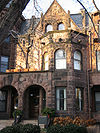 |
Saint Paul Saint Paul, Minnesota Saint Paul is the capital and second-most populous city of the U.S. state of Minnesota. The city lies mostly on the east bank of the Mississippi River in the area surrounding its point of confluence with the Minnesota River, and adjoins Minneapolis, the state's largest city... 44°56′28.97"N 93°7′29.03"W |
Ramsey Ramsey County, Minnesota Ramsey County is a county located in the U.S. state of Minnesota, founded in 1849. As of 2010, the population was 508,640. Its county seat is St. Paul, which is also Minnesota's state capital. The county is named for Alexander Ramsey , the first governor of the Minnesota Territory... |
The F. Scott Fitzgerald House was the home of Francis Scott Fitzgerald (1896–1940); as spokesman for the Jazz Age, he wrote several stories and his first published novel, This Side of Paradise This Side of Paradise This Side of Paradise is the debut novel of F. Scott Fitzgerald. Published in 1920, and taking its title from a line of the Rupert Brooke poem Tiare Tahiti, the book examines the lives and morality of post-World War I youth. Its protagonist, Amory Blaine, is an attractive Princeton University... in this Victorian Victorian architecture The term Victorian architecture refers collectively to several architectural styles employed predominantly during the middle and late 19th century. The period that it indicates may slightly overlap the actual reign, 20 June 1837 – 22 January 1901, of Queen Victoria. This represents the British and... rowhouse on Summit Avenue in Saint Paul Saint Paul, Minnesota Saint Paul is the capital and second-most populous city of the U.S. state of Minnesota. The city lies mostly on the east bank of the Mississippi River in the area surrounding its point of confluence with the Minnesota River, and adjoins Minneapolis, the state's largest city... . The novels The Beautiful and Damned The Beautiful and Damned The Beautiful and Damned, first published by Scribner's in 1922, is F. Scott Fitzgerald's second novel. The novel provides a portrait of the Eastern elite during the Jazz Age, exploring New York Café Society. As with his other novels, Fitzgerald's characters are complex, especially in their... and The Great Gatsby The Great Gatsby The Great Gatsby is a novel by the American author F. Scott Fitzgerald. First published in1925, it is set on Long Island's North Shore and in New York City from spring to autumn of 1922.... quickly followed. |
||
| 3 | Grand Mound | International Falls International Falls, Minnesota International Falls is a city in and the county seat of Koochiching County, Minnesota, United States. The population was 6,424 at the 2010 census.... |
Koochiching Koochiching County, Minnesota Koochiching County is a county located in the U.S. state of Minnesota. As of 2010, the population was 13,311. Its county seat is International Falls. A portion of the Bois Forte Indian Reservation is in the county. A small part of Voyageurs National Park extends into its northeast... |
|||
| 4 | Fort Snelling |  |
Minneapolis Minneapolis, Minnesota Minneapolis , nicknamed "City of Lakes" and the "Mill City," is the county seat of Hennepin County, the largest city in the U.S. state of Minnesota, and the 48th largest in the United States... 44.892778°N 93.180556°W |
Hennepin Hennepin County, Minnesota Hennepin County is a county located in the U.S. state of Minnesota, named in honor of the 17th-century explorer Father Louis Hennepin. As of 2010 the population was 1,152,425. Its county seat is Minneapolis. It is by far the most populous county in Minnesota; more than one in five Minnesotans live... |
Fort Snelling, originally known as Fort St. Anthony, is a former military Military A military is an organization authorized by its greater society to use lethal force, usually including use of weapons, in defending its country by combating actual or perceived threats. The military may have additional functions of use to its greater society, such as advancing a political agenda e.g... fortification Fortification Fortifications are military constructions and buildings designed for defence in warfare and military bases. Humans have constructed defensive works for many thousands of years, in a variety of increasingly complex designs... located at the confluence Confluence (geography) In geography, a confluence is the meeting of two or more bodies of water. It usually refers to the point where two streams flow together, merging into a single stream... of the Minnesota Minnesota River The Minnesota River is a tributary of the Mississippi River, approximately 332 miles long, in the U.S. state of Minnesota. It drains a watershed of nearly , in Minnesota and about in South Dakota and Iowa.... and Mississippi Mississippi River The Mississippi River is the largest river system in North America. Flowing entirely in the United States, this river rises in western Minnesota and meanders slowly southwards for to the Mississippi River Delta at the Gulf of Mexico. With its many tributaries, the Mississippi's watershed drains... Rivers in Hennepin County, Minnesota Hennepin County, Minnesota Hennepin County is a county located in the U.S. state of Minnesota, named in honor of the 17th-century explorer Father Louis Hennepin. As of 2010 the population was 1,152,425. Its county seat is Minneapolis. It is by far the most populous county in Minnesota; more than one in five Minnesotans live... . It is part of the Mississippi National River and Recreation Area Mississippi National River and Recreation Area The Mississippi National River and Recreation Area protects a and corridor along the Mississippi River from the cities of Dayton and Ramsey, Minnesota to just downstream of Hastings, Minnesota. This includes the stretch of Mississippi River which flows through Minneapolis and St. Paul, Minnesota... . |
|
| 5 | James J. Hill House James J. Hill House The James J. Hill House, in Saint Paul, Minnesota, was built by railroad magnate James J. Hill. The house, completed in 1891, is near the eastern end of Summit Avenue near the Cathedral of Saint Paul. The house, for its time, was very large and was the "showcase of St. Paul" until James J. Hill's... |
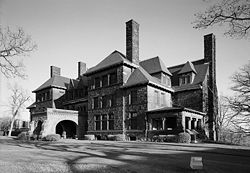 |
Saint Paul Saint Paul, Minnesota Saint Paul is the capital and second-most populous city of the U.S. state of Minnesota. The city lies mostly on the east bank of the Mississippi River in the area surrounding its point of confluence with the Minnesota River, and adjoins Minneapolis, the state's largest city... 44.945111°N 93.108806°W |
Ramsey Ramsey County, Minnesota Ramsey County is a county located in the U.S. state of Minnesota, founded in 1849. As of 2010, the population was 508,640. Its county seat is St. Paul, which is also Minnesota's state capital. The county is named for Alexander Ramsey , the first governor of the Minnesota Territory... |
The James J. Hill House, in Saint Paul, Minnesota Saint Paul, Minnesota Saint Paul is the capital and second-most populous city of the U.S. state of Minnesota. The city lies mostly on the east bank of the Mississippi River in the area surrounding its point of confluence with the Minnesota River, and adjoins Minneapolis, the state's largest city... , was built by railroad magnate James J. Hill James J. Hill James Jerome Hill , was a Canadian-American railroad executive. He was the chief executive officer of a family of lines headed by the Great Northern Railway, which served a substantial area of the Upper Midwest, the northern Great Plains, and Pacific Northwest... . The house, completed in 1891, is near the eastern end of Summit Avenue near the Cathedral of Saint Paul Cathedral of Saint Paul (Minnesota) The Cathedral of Saint Paul is a Roman Catholic cathedral in the city of St. Paul, Minnesota. It is the Co-Cathedral of the Archdiocese of Saint Paul and Minneapolis, along with the Basilica of St. Mary in Minneapolis. One of the most distinctive cathedrals in the United States, it sits on... . With 36,000 square feet (3,344 square meters) of living area, the house is the largest residence in Minnesota Minnesota Minnesota is a U.S. state located in the Midwestern United States. The twelfth largest state of the U.S., it is the twenty-first most populous, with 5.3 million residents. Minnesota was carved out of the eastern half of the Minnesota Territory and admitted to the Union as the thirty-second state... . |
|
| 6 | Hull-Rust-Mahoning Open Pit Iron Mine Hull-Rust-Mahoning Open Pit Iron Mine The Hull-Rust-Mahoning Mine in Hibbing, Minnesota, is one of the largest open pit iron mines in the world. The mine, located in the Mesabi Range, supplied as much as one-fourth of all the iron ore mined in the United States during its peak production during World War I and World War II.This area of... |
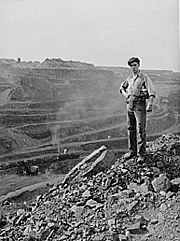 |
Hibbing Hibbing, Minnesota Hibbing is a city in Saint Louis County, Minnesota, United States. The population was 16,361 at the 2010 census. The city was built on the rich iron ore of the Mesabi Iron Range. At the edge of town is the largest open-pit iron mine in the world. U.S... 47.45°N 92.95°W |
St. Louis St. Louis County, Minnesota St. Louis County is a county located in the U.S. state of Minnesota. As of 2010, the population was 200,226. Its county seat is Duluth. It is the largest county by total area in Minnesota, and the second largest in the United States east of the Mississippi River; in land area alone, after Aroostook... |
The Hull-Rust-Mahoning Mine in Hibbing Hibbing, Minnesota Hibbing is a city in Saint Louis County, Minnesota, United States. The population was 16,361 at the 2010 census. The city was built on the rich iron ore of the Mesabi Iron Range. At the edge of town is the largest open-pit iron mine in the world. U.S... , Minnesota Minnesota Minnesota is a U.S. state located in the Midwestern United States. The twelfth largest state of the U.S., it is the twenty-first most populous, with 5.3 million residents. Minnesota was carved out of the eastern half of the Minnesota Territory and admitted to the Union as the thirty-second state... , is the largest open pit iron mine Open-pit mining Open-pit mining or opencast mining refers to a method of extracting rock or minerals from the earth by their removal from an open pit or borrow.... in the world. The mine, located in the Mesabi Range Mesabi Range The Mesabi Iron Range is a vast deposit of iron ore and the largest of four major iron ranges in the region collectively known as the Iron Range of Minnesota. Discovered in 1866, it is the chief deposit of iron ore in the United States. The deposit is located in northeast Minnesota, largely in... , supplied as much as one-fourth of all the iron ore mined in the United States United States The United States of America is a federal constitutional republic comprising fifty states and a federal district... during its peak production years of World War I World War I World War I , which was predominantly called the World War or the Great War from its occurrence until 1939, and the First World War or World War I thereafter, was a major war centred in Europe that began on 28 July 1914 and lasted until 11 November 1918... and World War II World War II World War II, or the Second World War , was a global conflict lasting from 1939 to 1945, involving most of the world's nations—including all of the great powers—eventually forming two opposing military alliances: the Allies and the Axis... . This area of the Mesabi Range was explored in 1893–1894, shortly after the Mountain Iron Mountain Iron, Minnesota As of the census of 2000, there were 2,999 people, 1,326 households, and 847 families residing in the city. The population density was 60.7 people per square mile . There were 1,409 housing units at an average density of 28.5 per square mile... mine was established in 1892. The early development was as an underground mine, but open cast mining soon proved to be a better choice because of the soft, shallow ore deposits. Many open pits in the area soon merged into one large mine, and the consolidation of mines led to the formation of U.S. Steel U.S. Steel The United States Steel Corporation , more commonly known as U.S. Steel, is an integrated steel producer with major production operations in the United States, Canada, and Central Europe. The company is the world's tenth largest steel producer ranked by sales... in 1901. The growth of the mine even resulted in the town of Hibbing being relocated to accommodate expansion. |
|
| Kathio Historic District Mille Lacs Kathio State Park Mille Lacs Kathio State Park, also known as Kathio Site, is a Minnesota state park on Mille Lacs Lake. The park preserves habitation sites and mound groups, believed to date between 3000 BC and 1750 AD, that document Sioux Indian culture and Ojibwe-Sioux relationships... |
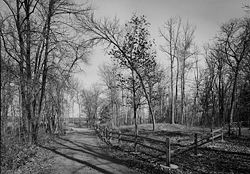 |
Vineland Vineland, Minnesota Vineland is a census-designated place in Mille Lacs County, Minnesota, United States. The population was 607 at the 2000 census. As with other CDPs, the area and population values are included in aggregate values for its township... 46.163611°N 93.7575°W |
Mille Lacs Mille Lacs County, Minnesota As of the census of 2000, there were 22,330 people, 8,638 households, and 6,003 families residing in the county. The population density was 39 people per square mile . There were 10,467 housing units at an average density of 18 per square mile... |
The Kathio Historic District preserves habitation sites and mound groups, believed to date between 3000 BC and 1750 AD, that document Sioux Sioux The Sioux are Native American and First Nations people in North America. The term can refer to any ethnic group within the Great Sioux Nation or any of the nation's many language dialects... Indian culture and Ojibwe-Sioux relationships. The park contains 19 identified archaeological sites, making it one of the most significant archaeological collections in Minnesota. The earliest site dates to the Archaic period and shows evidence of copper tool manufacture. |
||
| 8 | Oliver H. Kelley Homestead Oliver H. Kelley Homestead The Oliver H. Kelley Farm is a historic farmstead once owned by Oliver Hudson Kelley, one of the founders of the Order of Patrons of Husbandry. The farmstead is a U.S. National Historic Landmark, which also places it on the National Register of Historic Places. The farm is currently operated as a... |
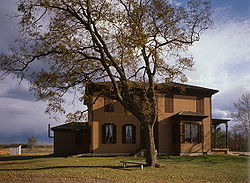 |
Elk River Elk River, Minnesota As of the census of 2000, there were 16,447 people, 5,664 households, and 4,400 families residing in the city. Recent estimates show the population at 21,329 as of 2005. The population density was 385.5 people per square mile . There were 5,782 housing units at an average density of 135.5 per... 45.313601°N 93.5814°W |
Sherburne Sherburne County, Minnesota As of the census of 2000, there were 64,417 people, 21,581 households, and 16,746 families residing in the county. The population density was 148 people per square mile . There were 22,827 housing units at an average density of 52 per square mile... |
The Oliver H. Kelley Homestead is an historic farmstead once owned by Oliver Hudson Kelley Oliver Hudson Kelley Oliver Hudson Kelley is considered the "Father" of the Order of Patrons of Husbandry.-Biography:In Boston, he moved to the Minnesota frontier in 1849, where he became a farmer... , one of the founders of the Order of Patrons of Husbandry Grange movement The National Grange of the Order of Patrons of Husbandry, also simply styled the Grange, is a fraternal organization for American farmers that encourages farm families to band together for their common economic and political well-being... . Oliver Kelley moved to Minnesota in 1849, the year that Minnesota Territory Minnesota Territory The Territory of Minnesota was an organized incorporated territory of the United States that existed from March 3, 1849, until May 11, 1858, when the eastern portion of the territory was admitted to the Union as the State of Minnesota.-History:... was formed. Although he knew little about farming, he taught himself using agricultural journals and correspondence with other "scientific-oriented" farmers. He became an expert on farming in Minnesota, and he learned how adverse events such as bad weather, debt, insect pests, and crop failures could devastate a farmer's fortunes. |
|
| 9 | Frank B. Kellogg House Frank B. Kellogg House The Frank B. Kellogg House is a house in Saint Paul, Minnesota. The house is listed as a National Historic Landmark for its association with Senator Frank B. Kellogg, co-author of the Kellogg-Briand Pact. Kellogg Boulevard in downtown Saint Paul is also named for him.From 1889 until his death,... |
 |
Saint Paul Saint Paul, Minnesota Saint Paul is the capital and second-most populous city of the U.S. state of Minnesota. The city lies mostly on the east bank of the Mississippi River in the area surrounding its point of confluence with the Minnesota River, and adjoins Minneapolis, the state's largest city... 44°56′14.09"N 93°7′35.8"W |
Ramsey Ramsey County, Minnesota Ramsey County is a county located in the U.S. state of Minnesota, founded in 1849. As of 2010, the population was 508,640. Its county seat is St. Paul, which is also Minnesota's state capital. The county is named for Alexander Ramsey , the first governor of the Minnesota Territory... |
From 1889 until his death, this was the permanent residence of Frank B. Kellogg Frank B. Kellogg Frank Billings Kellogg was an American lawyer, politician and statesman who served in the U.S. Senate and as U.S. Secretary of State. He co-authored the Kellogg-Briand Pact, for which he was awarded the Nobel Peace Prize for 1929..- Biography :Kellogg was born in Potsdam, New York, and his family... (1856–1937), lawyer, U.S. Senator, and diplomat. As Secretary of State United States Secretary of State The United States Secretary of State is the head of the United States Department of State, concerned with foreign affairs. The Secretary is a member of the Cabinet and the highest-ranking cabinet secretary both in line of succession and order of precedence... (1925–29), he negotiated the Kellogg-Briand Pact Kellogg-Briand Pact The Kellogg–Briand Pact was an agreement signed on August 27, 1928, by the United States, France, the United Kingdom, Italy, Japan, Weimar Germany and a number of other countries.The pact renounced war , prohibiting the use of war... (1928), for which he received the Nobel Peace Prize Nobel Peace Prize The Nobel Peace Prize is one of the five Nobel Prizes bequeathed by the Swedish industrialist and inventor Alfred Nobel.-Background:According to Nobel's will, the Peace Prize shall be awarded to the person who... , and shifted foreign policy away from interventionism. |
|
| 10 | Sinclair Lewis Boyhood Home Sinclair Lewis Boyhood Home The Sinclair Lewis Boyhood Home, located at 812 Sinclair Lewis Avenue, formerly South 3rd Street, Sauk Centre, Minnesota in the United States, was the childhood home of Nobel prize-winning author Sinclair Lewis, who was born February 7, 1885, in a house directly across the street... |
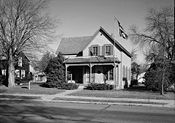 |
Sauk Centre Sauk Centre, Minnesota As of the census of 2000, there were 3,930 people, 1,616 households, and 1,042 families residing in the city. The population density was 1,057.2 people per square mile . There were 1,709 housing units at an average density of 459.7 per square mile... 45.737128°N 94.956976°W |
Stearns Stearns County, Minnesota As of the census of 2000, there were 133,166 people, 47,604 households, and 32,132 families residing in the county. The population density was 99 people per square mile . There were 50,291 housing units at an average density of 37 per square mile... |
From 1885 to 1902, this was the home of Sinclair Lewis Sinclair Lewis Harry Sinclair Lewis was an American novelist, short-story writer, and playwright. In 1930, he became the first writer from the United States to be awarded the Nobel Prize in Literature, "for his vigorous and graphic art of description and his ability to create, with wit and humor, new types of... (1885–1951) the first American author to be awarded the Nobel Prize for literature (1930). His novel Main Street Main Street (novel) - Plot summary :Carol Milford is a liberal, free-spirited young woman, reared in the metropolis of Saint Paul, Minnesota. She marries Will Kennicott, a doctor, who is a small-town boy at heart.... (1920) was partly based on his impressions of Sauk Centre, Minnesota Sauk Centre, Minnesota As of the census of 2000, there were 3,930 people, 1,616 households, and 1,042 families residing in the city. The population density was 1,057.2 people per square mile . There were 1,709 housing units at an average density of 459.7 per square mile... . |
|
| 11 | Charles A. Lindbergh House and Park Charles A. Lindbergh State Park Charles A. Lindbergh State Park is a 569 acre Minnesota state park on the outskirts of Little Falls. The park was once the farm of Congressman Charles August Lindbergh and his son Charles Lindbergh, the famous aviator. Their restored 1906 house and two other farm buildings are within the park... |
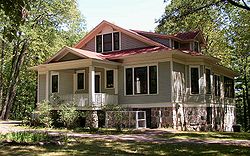 |
Little Falls Little Falls, Minnesota As of the census of 2000, there were 7,719 people , 3,197 households, and 1,899 families residing in the city. The population density was 1,232.5 people per square mile . There were 3,358 housing units at an average density of 536.2 per square mile... 45.957439°N 94.389789°W |
Morrison Morrison County, Minnesota -Demographics:As of the census of 2000, there were 31,712 people, 11,816 households, and 8,460 families residing in the county. The population density was 28 people per square mile . There were 13,870 housing units at an average density of 12 per square mile... |
The Charles A. Lindbergh House and Park was once the farm of Congressman Charles August Lindbergh Charles August Lindbergh Charles August Lindbergh Sr. was a United States Congressman from Minnesota's 6th congressional district from 1907 to 1917... and his son Charles Lindbergh Charles Lindbergh Charles Augustus Lindbergh was an American aviator, author, inventor, explorer, and social activist.Lindbergh, a 25-year-old U.S... , the famous aviator. Their restored 1906 house and two other farm buildings are within the park boundaries. Three buildings and three structures built by the Works Progress Administration Works Progress Administration The Works Progress Administration was the largest and most ambitious New Deal agency, employing millions of unskilled workers to carry out public works projects, including the construction of public buildings and roads, and operated large arts, drama, media, and literacy projects... in the 1930s were named to the National Register of Historic Places National Register of Historic Places The National Register of Historic Places is the United States government's official list of districts, sites, buildings, structures, and objects deemed worthy of preservation... . These buildings include a picnic shelter and a water tower, built in the Rustic Style from local stone and logs, and have remained relatively unchanged since construction. |
|
| 12 | Mayo Clinic Building (Plummer Building) Plummer Building The Plummer Building in Rochester, Minnesota is one of the many architecturally significant buildings on the Mayo Clinic campus. This new "Mayo Clinic" building, opened in 1927, added much needed space to the ever expanding Mayo practice. The architect of record is Ellerbe & Co. It was the third... |
 |
Rochester Rochester, Minnesota Rochester is a city in the U.S. state of Minnesota and is the county seat of Olmsted County. Located on both banks of the Zumbro River, The city has a population of 106,769 according to the 2010 United States Census, making it Minnesota's third-largest city and the largest outside of the... 44.021667°N 92.465556°W |
Olmsted Olmsted County, Minnesota As of the census of 2000, there were 124,277 people, 47,807 households, and 32,317 families residing in the county. The population density was 190 people per square mile . There were 49,422 housing units at an average density of 76 per square mile... |
The Plummer Building is an architecturally significant part of the Mayo Clinic Mayo Clinic Mayo Clinic is a not-for-profit medical practice and medical research group specializing in treating difficult patients . Patients are referred to Mayo Clinic from across the U.S. and the world, and it is known for innovative and effective treatments. Mayo Clinic is known for being at the top of... . It was originally called the 1929 building, but was renamed the Plummer Building after its chief architect and Mayo Clinic co-founder, Henry Stanley Plummer Henry Stanley Plummer Henry Stanley Plummer, M.D. was a prominent internist and endocrinologist who, along with Drs. William Mayo, Charles Mayo, Stinchfield, E. Starr Judd, Christopher Graham, and Donald Balfour founded Mayo Clinic. Dr... . It was the tallest building in Rochester Rochester, Minnesota Rochester is a city in the U.S. state of Minnesota and is the county seat of Olmsted County. Located on both banks of the Zumbro River, The city has a population of 106,769 according to the 2010 United States Census, making it Minnesota's third-largest city and the largest outside of the... , Minnesota Minnesota Minnesota is a U.S. state located in the Midwestern United States. The twelfth largest state of the U.S., it is the twenty-first most populous, with 5.3 million residents. Minnesota was carved out of the eastern half of the Minnesota Territory and admitted to the Union as the thirty-second state... from its construction in 1929 until 2001 when the nearby Gonda Building Gonda Building The Gonda Building is a medical building owned by the Mayo Clinic in Rochester, Minnesota, and designed by Ellerbe Becket Architects and Engineers.It rises 305 feet in 21 floors, and was completed in 2001.... was completed. |
|
| 13 | Mountain Iron Mine Mountain Iron Mine The discovery of Mountain Iron Mine in Mountain Iron, Minnesota in 1890 represents the beginning of the exploitation of the Mesabi Range iron ore in the Iron Range of northeast Minnesota. The Mesabi Range and nearby Vermilion Range led Minnesota to become the nation's largest producer of iron ore... |
 |
Mountain Iron Mountain Iron, Minnesota As of the census of 2000, there were 2,999 people, 1,326 households, and 847 families residing in the city. The population density was 60.7 people per square mile . There were 1,409 housing units at an average density of 28.5 per square mile... 47.54°N 92.62°W |
St. Louis St. Louis County, Minnesota St. Louis County is a county located in the U.S. state of Minnesota. As of 2010, the population was 200,226. Its county seat is Duluth. It is the largest county by total area in Minnesota, and the second largest in the United States east of the Mississippi River; in land area alone, after Aroostook... |
Discovered in 1890, the Mountain Iron Mine's first shipment of iron ore occurred in 1892. The mine's production led to the realization that the Mesabi Range Mesabi Range The Mesabi Iron Range is a vast deposit of iron ore and the largest of four major iron ranges in the region collectively known as the Iron Range of Minnesota. Discovered in 1866, it is the chief deposit of iron ore in the United States. The deposit is located in northeast Minnesota, largely in... possessed the world's largest deposits of iron ore, making Minnesota the nation's premier supplier of the resource. |
|
| 14 | National Farmer's Bank of Owatonna National Farmer's Bank of Owatonna The National Farmers' Bank of Owatonna, Minnesota is a bank building designed by Louis Sullivan with decorative elements by George Elmslie. It was built in 1908, and was the first of Sullivan's "jewel boxes". The building is clad in red brick with green terra cotta bands, and features two large... |
 |
Owatonna Owatonna, Minnesota Owatonna is a city in Steele County, Minnesota, United States. The population was 25,599 at the 2010 census. It is the county seat of Steele County. Owatonna is home to the Steele County Fairgrounds, which hosts the Steele County Free Fair in August.... 44.0851°N 93.22575°W |
Steele Steele County, Minnesota As of the census of 2000, there were 33,680 people, 12,846 households, and 9,082 families residing in the county. The population density was 78 people per square mile . There were 13,306 housing units at an average density of 31 per square mile... |
The National Farmers' Bank of Owatonna Owatonna, Minnesota Owatonna is a city in Steele County, Minnesota, United States. The population was 25,599 at the 2010 census. It is the county seat of Steele County. Owatonna is home to the Steele County Fairgrounds, which hosts the Steele County Free Fair in August.... , Minnesota Minnesota Minnesota is a U.S. state located in the Midwestern United States. The twelfth largest state of the U.S., it is the twenty-first most populous, with 5.3 million residents. Minnesota was carved out of the eastern half of the Minnesota Territory and admitted to the Union as the thirty-second state... is a bank building designed by Louis Sullivan Louis Sullivan Louis Henri Sullivan was an American architect, and has been called the "father of skyscrapers" and "father of modernism" He is considered by many as the creator of the modern skyscraper, was an influential architect and critic of the Chicago School, was a mentor to Frank Lloyd Wright, and an... with decorative elements by George Elmslie George Grant Elmslie George Grant Elmslie was an American, though born in Aberdeenshire, Scotland, Prairie School architect whose work is mostly found in the Midwestern United States... . It was built in 1908, and was the first of Sullivan's "jewel boxes". The building is clad in red brick with green terra cotta Glazed architectural terra-cotta Glazed architectural terra-cotta is a ceramic masonry building material popular in the United States from the late 19th century until the 1930s, and still one of the most common building materials found in U.S. urban environments... bands, and features two large arch Arch An arch is a structure that spans a space and supports a load. Arches appeared as early as the 2nd millennium BC in Mesopotamian brick architecture and their systematic use started with the Ancient Romans who were the first to apply the technique to a wide range of structures.-Technical aspects:The... es. Internal elements include a stained glass Stained glass The term stained glass can refer to coloured glass as a material or to works produced from it. Throughout its thousand-year history, the term has been applied almost exclusively to the windows of churches and other significant buildings... window designed by Louis J. Millet, a mural Mural A mural is any piece of artwork painted or applied directly on a wall, ceiling or other large permanent surface. A particularly distinguishing characteristic of mural painting is that the architectural elements of the given space are harmoniously incorporated into the picture.-History:Murals of... by Oskar Gross, and a cast iron electrolier Electrolier Electrolier was the name for a fixture, usually pendent from the ceiling, for holding electric lamps. The word is analogous to chandelier, from which it was formed.... by William Winslow. |
|
| 15 | Peavey-Haglin Experimental Concrete Grain Elevator Peavey-Haglin Experimental Concrete Grain Elevator The Peavey–Haglin Experimental Concrete Grain Elevator, built in 1899–1900, was the first circular concrete grain elevator in the United States, and possibly in the world. It is notable for proving the viability of concrete in grain elevator construction. Previous grain elevators, being... |
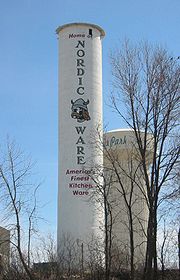 |
St. Louis Park St. Louis Park, Minnesota As of the census of 2000, there were 44,126 people, 20,782 households, and 10,557 families residing in the city. The population density was 4,122.5 persons per square mile . There were 21,140 housing units at an average density of 1,975.0 per square mile... 44.9425°N 93.345278°W |
Hennepin Hennepin County, Minnesota Hennepin County is a county located in the U.S. state of Minnesota, named in honor of the 17th-century explorer Father Louis Hennepin. As of 2010 the population was 1,152,425. Its county seat is Minneapolis. It is by far the most populous county in Minnesota; more than one in five Minnesotans live... |
The Peavey-Haglin Experimental Concrete Grain Elevator, built in 1899-1900, was the first circular concrete grain elevator Grain elevator A grain elevator is a tower containing a bucket elevator, which scoops up, elevates, and then uses gravity to deposit grain in a silo or other storage facility... in the United States, and possibly in the world. It is notable for proving the viability of concrete in grain elevator construction. Previous grain elevators, being built of wood, were expensive to build and vulnerable to fire. It was located along the Minneapolis and St. Louis Railway Minneapolis and St. Louis Railway The Minneapolis and St. Louis Railway was an American Class I railroad that built and operated lines radiating south and west from Minneapolis, Minnesota which existed for 90 years from 1870 to 1960.... . |
|
| 16 | Pillsbury "A" Mill | 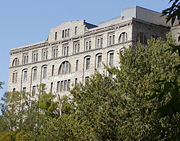 |
Minneapolis Minneapolis, Minnesota Minneapolis , nicknamed "City of Lakes" and the "Mill City," is the county seat of Hennepin County, the largest city in the U.S. state of Minnesota, and the 48th largest in the United States... 44.983939°N 93.252664°W |
Hennepin Hennepin County, Minnesota Hennepin County is a county located in the U.S. state of Minnesota, named in honor of the 17th-century explorer Father Louis Hennepin. As of 2010 the population was 1,152,425. Its county seat is Minneapolis. It is by far the most populous county in Minnesota; more than one in five Minnesotans live... |
The Pillsbury "A" Mill, situated along Saint Anthony Falls Saint Anthony Falls Saint Anthony Falls, or the Falls of Saint Anthony, located northeast of downtown Minneapolis, Minnesota, was the only natural major waterfall on the Upper Mississippi River. The natural falls was replaced by a concrete overflow spillway after it partially collapsed in 1869... on the Mississippi River Mississippi River The Mississippi River is the largest river system in North America. Flowing entirely in the United States, this river rises in western Minnesota and meanders slowly southwards for to the Mississippi River Delta at the Gulf of Mexico. With its many tributaries, the Mississippi's watershed drains... in Minneapolis, Minnesota Minneapolis, Minnesota Minneapolis , nicknamed "City of Lakes" and the "Mill City," is the county seat of Hennepin County, the largest city in the U.S. state of Minnesota, and the 48th largest in the United States... , held the title of largest flour mill in the world for 40 years. Completed in 1881, it was owned by Pillsbury and operated two of the most powerful direct-drive waterwheels ever built, each generating 1,200 horsepower Horsepower Horsepower is the name of several units of measurement of power. The most common definitions equal between 735.5 and 750 watts.Horsepower was originally defined to compare the output of steam engines with the power of draft horses in continuous operation. The unit was widely adopted to measure the... (895 kW). The mill still stands today on the east side of the Mississippi River, but ceased operation in 2003. |
|
| 17 | Rabideau CCC Camp Rabideau CCC Camp The Rabideau CCC Camp was a Civilian Conservation Corps camp in the Chippewa National Forest in northern Minnesota. The camp was established in 1935 as a project of Franklin D. Roosevelt's New Deal program. The camp, one of 2650 nationwide, was home to about 300 men aged 17–21... |
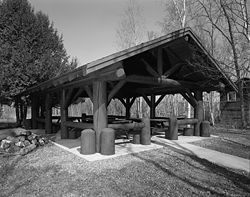 |
Chippewa National Forest Chippewa National Forest Chippewa National Forest is a National Forest located in northcentral Minnesota, United States, in the counties of Itasca, Cass, and Beltrami. Forest headquarters are located in Cass Lake, Minnesota. There are local ranger district offices in Blackduck, Deer River, and Walker.-History and... 47.639986°N 94.548622°W |
Beltrami Beltrami County, Minnesota Beltrami County is a county located in the northern part of the U.S. state of Minnesota. As of 2010, the population was 44,442. Its county seat is Bemidji. Portions of the Leech Lake and Red Lake Indian reservations are in the county. The northernmost portion of the Mississippi River flows... |
The Rabideau CCC Camp was a Civilian Conservation Corps Civilian Conservation Corps The Civilian Conservation Corps was a public work relief program that operated from 1933 to 1942 in the United States for unemployed, unmarried men from relief families, ages 18–25. A part of the New Deal of President Franklin D... camp in the Chippewa National Forest Chippewa National Forest Chippewa National Forest is a National Forest located in northcentral Minnesota, United States, in the counties of Itasca, Cass, and Beltrami. Forest headquarters are located in Cass Lake, Minnesota. There are local ranger district offices in Blackduck, Deer River, and Walker.-History and... in northern Minnesota Minnesota Minnesota is a U.S. state located in the Midwestern United States. The twelfth largest state of the U.S., it is the twenty-first most populous, with 5.3 million residents. Minnesota was carved out of the eastern half of the Minnesota Territory and admitted to the Union as the thirty-second state... . The camp was established in 1935 as a project of Franklin D. Roosevelt Franklin D. Roosevelt Franklin Delano Roosevelt , also known by his initials, FDR, was the 32nd President of the United States and a central figure in world events during the mid-20th century, leading the United States during a time of worldwide economic crisis and world war... 's New Deal New Deal The New Deal was a series of economic programs implemented in the United States between 1933 and 1936. They were passed by the U.S. Congress during the first term of President Franklin D. Roosevelt. The programs were Roosevelt's responses to the Great Depression, and focused on what historians call... program. The camp, one of 2650 nationwide, was home to about 300 men aged 17–21. Like most CCC camps, the Rabideau camp was established to provide work to those unemployed as a result of the Great Depression Great Depression The Great Depression was a severe worldwide economic depression in the decade preceding World War II. The timing of the Great Depression varied across nations, but in most countries it started in about 1929 and lasted until the late 1930s or early 1940s... . Enrollees at the camp came mostly from Northern Minnesota and worked on projects within the Chippewa National Forest, such as building roads and other facilities, surveying, wildlife protection, and other forestry activities. |
|
| 18 | O. E. Rolvaag House O. E. Rolvaag House The O. E. Rølvaag House was the home of Ole Edvart Rølvaag , Norwegian-American novelist and professor at St. Olaf College. The home is located at 311 Manitou Street in Northfield, Minnesota. Rølvaag wrote most of his works in this house, which is near St... |
 |
Northfield Northfield, Minnesota As of the census of 2000, there were 17,147 people, 4,909 households, and 3,210 families residing in the city. The population density was 2,452.2 people per square mile . There were 5,119 housing units at an average density of 732.1 per square mile... 44°27′47.54"N 93°10′19.99"W |
Rice Rice County, Minnesota As of the census of 2000, there were 56,665 people, 18,888 households, and 13,353 families residing in the county. The population density was 114 people per square mile . There were 20,061 housing units at an average density of 40 per square mile... |
From 1912 until his death, this was the residence of Ole Edvart Rølvaag Ole Edvart Rølvaag Ole Edvart Rølvaag was an American novelist and professor who became well known for his writings regarding the Norwegian American immigrant experience... (1876–1931), Norwegian immigrant and the first American novelist to give a true accounting of the psychological cost of pioneering on the farmer's frontier. His famous trilogy—Giants in the Earth (1927), Peder Victorious (1928), and Their Father's God (1931)—stands in our literature as the most mature and penetrating assessment of the adjustments immigrant pioneers had to make in order to find peace and prosperity in middle America Midwestern United States The Midwestern United States is one of the four U.S. geographic regions defined by the United States Census Bureau, providing an official definition of the American Midwest.... . |
|
| 19 | St. Croix Boom Site St. Croix Boom Site The St. Croix Boom Site is a National Historic Landmark located on the St. Croix River upstream of Stillwater, Minnesota. The site was founded by Stillwater lumber barons, including Isaac Staples, in 1856 after the demise of the original St. Croix Boom Company, which had operated a log boom further... |
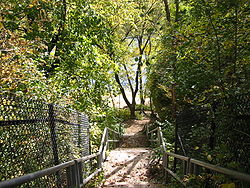 |
Stillwater Stillwater, Minnesota As of the census of 2000, there were 15,143 people, 5,797 households, and 4,115 families residing in the city. The population density was 2,340.0 people per square mile . There were 5,926 housing units at an average density of 915.7 per square mile... 45.078°N 92.798°W |
Washington Washington County, Minnesota Washington County is a county established in 1849 in the U.S. state of Minnesota. As of 2010, the population was 238,136. Its county seat is Stillwater.-History:... |
The St. Croix Boom Site is located on the St. Croix River St. Croix River (Wisconsin-Minnesota) The St. Croix River is a tributary of the Mississippi River, approximately long, in the U.S. states of Wisconsin and Minnesota. The lower of the river form the border between Wisconsin and Minnesota. The river is a National Scenic Riverway under the protection of the National Park Service. A... upstream of Stillwater, Minnesota Stillwater, Minnesota As of the census of 2000, there were 15,143 people, 5,797 households, and 4,115 families residing in the city. The population density was 2,340.0 people per square mile . There were 5,926 housing units at an average density of 915.7 per square mile... . The site was founded by Stillwater lumber Timber Timber may refer to:* Timber, a term common in the United Kingdom and Australia for wood materials * Timber, Oregon, an unincorporated community in the U.S... barons, including Isaac Staples Isaac Staples Isaac Staples was a powerful lumber baron in the St. Croix River Valley during the logging boom of the late 19th century.Aside from his massive holdings and operations in timber, sawmills and the St... , in 1856 after the demise of the original St. Croix Boom Company, which had operated a boom further upstream near Marine on St. Croix, Minnesota Marine on St. Croix, Minnesota Marine on St. Croix is a city in Washington County, Minnesota, United States. The population was 689 at the 2010 census.-Geography:According to the United States Census Bureau, the city has a total area of , of which, of it is land and of it is water. Minnesota State Highway 95 serves as a main... . Staples and others purchased the Boom Company and moved the site downstream. |
|
| 20 | St. Croix Recreational Demonstration Area | 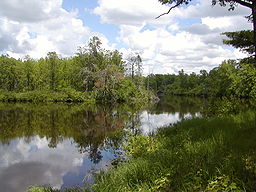 |
Hinckley Hinckley, Minnesota As of the census of 2000, there were 1,291 people, 551 households, and 332 families residing in the city. The population density was 454.3 people per square mile . There were 614 housing units at an average density of 216.0 per square mile... 46.011389°N 92.944444°W |
Pine Pine County, Minnesota As of the census of 2000, there were 26,530 people, 9,939 households, and 6,917 families residing in the county. The population density was 19 people per square mile . There were 15,353 housing units at an average density of 11 per square mile... |
The land in the St. Croix Recreational Demonstration Area was used for logging Logging Logging is the cutting, skidding, on-site processing, and loading of trees or logs onto trucks.In forestry, the term logging is sometimes used in a narrow sense concerning the logistics of moving wood from the stump to somewhere outside the forest, usually a sawmill or a lumber yard... between the mid-19th century and about 1915. After the logging era was over, farmers were attracted to the newly cleared land, but the soil was poor and not productive enough to make a living. In 1934, 18,000 acres (73 km²) of farmland was purchased, and the following year, the St. Croix Recreational Demonstration Area was started. Under the direction of the National Park Service National Park Service The National Park Service is the U.S. federal agency that manages all national parks, many national monuments, and other conservation and historical properties with various title designations... , the Works Progress Administration Works Progress Administration The Works Progress Administration was the largest and most ambitious New Deal agency, employing millions of unskilled workers to carry out public works projects, including the construction of public buildings and roads, and operated large arts, drama, media, and literacy projects... and the Civilian Conservation Corps Civilian Conservation Corps The Civilian Conservation Corps was a public work relief program that operated from 1933 to 1942 in the United States for unemployed, unmarried men from relief families, ages 18–25. A part of the New Deal of President Franklin D... built group camps, roads, and campgrounds. |
|
| 21 | Soudan Iron Mine | 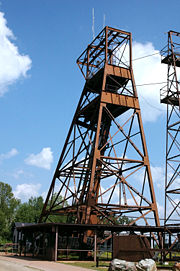 |
Tower Tower, Minnesota As of the census of 2000, there are 479 people in the city, organized into 233 households and 137 families. The population density is 176.8 people per square mile . There are 295 housing units at an average density of 108.9 per square mile... 47.857908°N 92.299611°W |
St. Louis St. Louis County, Minnesota St. Louis County is a county located in the U.S. state of Minnesota. As of 2010, the population was 200,226. Its county seat is Duluth. It is the largest county by total area in Minnesota, and the second largest in the United States east of the Mississippi River; in land area alone, after Aroostook... |
The Soudan Underground Mine is known as Minnesota's oldest, deepest, and richest iron mine Mining Mining is the extraction of valuable minerals or other geological materials from the earth, from an ore body, vein or seam. The term also includes the removal of soil. Materials recovered by mining include base metals, precious metals, iron, uranium, coal, diamonds, limestone, oil shale, rock... , and now hosts the Soudan Underground Laboratory. In the late 19th century, prospectors searching for gold Gold Gold is a chemical element with the symbol Au and an atomic number of 79. Gold is a dense, soft, shiny, malleable and ductile metal. Pure gold has a bright yellow color and luster traditionally considered attractive, which it maintains without oxidizing in air or water. Chemically, gold is a... in northern Minnesota discovered extremely rich veins of hematite Hematite Hematite, also spelled as haematite, is the mineral form of iron oxide , one of several iron oxides. Hematite crystallizes in the rhombohedral system, and it has the same crystal structure as ilmenite and corundum... at this site, often containing more than 65% iron Iron Iron is a chemical element with the symbol Fe and atomic number 26. It is a metal in the first transition series. It is the most common element forming the planet Earth as a whole, forming much of Earth's outer and inner core. It is the fourth most common element in the Earth's crust... . An open pit mine began operation in 1882, and moved to underground mining by 1900 for reasons of safety. From 1901 until the end of active mining in 1962, the Soudan Mine was owned by the United States Steel Corporation's Oliver Iron Mining division. By 1912 the mine was at a depth of 1,250 feet (381 m). When it closed, level 27 was being developed at 2,341 feet (713.5 m) below the surface. US Steel then donated the Soudan Mine to the State of Minnesota to use for educational purposes. |
|
| 22 | Split Rock Light Station | 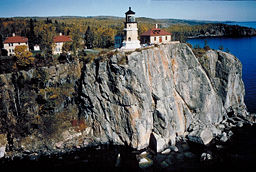 |
Beaver Bay Beaver Bay, Minnesota Beaver Bay is a city in Lake County, Minnesota, U.S. The population was 181 at the 2010 census.-History:It is the oldest settlement on the NorthShore of Lake Superior. Est. in 1856... 47°12′0"N 91°22′1"W |
Lake Lake County, Minnesota Lake County is a county located in the U.S. state of Minnesota. As of 2010, the population was 10,866. Its county seat is Two Harbors. Lake County was founded on February 20, 1855, as Superior County, though its name was changed on March 3, of that year to St. Louis County. On March 1, 1856, St... |
||
| 23 | Thorstein Veblen Farmstead Thorstein Veblen Farmstead Thorstein B. Veblen , economist, social scientist, and critic of American culture, lived on this farm as a youth and returned often as an adult. The product of an austere agrarian upbringing, Veblen has often been called one of America's most creative and original thinkers... |
 |
Nerstrand Nerstrand, Minnesota Nerstrand is a small town in Rice County, Minnesota, United States. The population was 295 at the 2010 census.Minnesota State Highway 246 serves as a main route in the community. Minnesota State Highways 56 and 60 are nearby.- History :... 44.35°N 93.05°W |
Rice Rice County, Minnesota As of the census of 2000, there were 56,665 people, 18,888 households, and 13,353 families residing in the county. The population density was 114 people per square mile . There were 20,061 housing units at an average density of 40 per square mile... |
The Thorstein Veblen Farmstead consists of the home and farm buildings where Thorstein B. Veblen (1857–1929) grew up. As an economist, social scientist, and critic of American culture, he was the product of an austere agrarian upbringing; Veblen has often been called one of America's most creative and original thinkers. | |
| 24 | Andrew John Volstead House Andrew John Volstead House The Andrew John Volstead House, located at 163 Ninth Avenue, Granite Falls, in the U.S. state of Minnesota was the home of Andrew Volstead . He personified prohibition to the American people, having authored the National Prohibition Act of 1919... |
 |
Granite Falls Granite Falls, Minnesota As of the census of 2000, there were 3,070 people, 1,344 households, and 806 families residing in the city. The population density was 890.5 people per square mile . There were 1,472 housing units at an average density of 427.0 per square mile... 44.809415°N 95.540020°W |
Yellow Medicine Yellow Medicine County, Minnesota -External links:***... |
From 1894 to 1930, this was the home of Andrew J. Volstead (1860–1947), the man who "personified prohibition." Volstead served in the U.S. House of Representatives (1903–23), where he drafted the National Prohibition Enforcement Act (1919), which became known as the Volstead Act Volstead Act The National Prohibition Act, known informally as the Volstead Act, was the enabling legislation for the Eighteenth Amendment which established prohibition in the United States... . |
|
| 25 | Washburn "A" Mill | 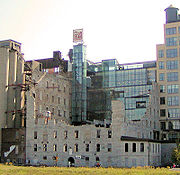 |
Minneapolis Minneapolis, Minnesota Minneapolis , nicknamed "City of Lakes" and the "Mill City," is the county seat of Hennepin County, the largest city in the U.S. state of Minnesota, and the 48th largest in the United States... 44.978889°N 93.256944°W |
Hennepin Hennepin County, Minnesota Hennepin County is a county located in the U.S. state of Minnesota, named in honor of the 17th-century explorer Father Louis Hennepin. As of 2010 the population was 1,152,425. Its county seat is Minneapolis. It is by far the most populous county in Minnesota; more than one in five Minnesotans live... |
The Washburn "A" Mill complex was the second-largest flour mill in Minneapolis, Minnesota Minneapolis, Minnesota Minneapolis , nicknamed "City of Lakes" and the "Mill City," is the county seat of Hennepin County, the largest city in the U.S. state of Minnesota, and the 48th largest in the United States... . The original mill was built in 1874 by Cadwallader C. Washburn Cadwallader C. Washburn Cadwallader Colden Washburn was an American businessman, politician, and soldier noted for founding what would later become General Mills and working in government for Wisconsin. He was born in Livermore, Maine, one of seven brothers that included Israel Washburn, Jr., Elihu B. Washburne, William D... , but destroyed in an explosion in 1878, killing 18. The mill was later rebuilt, and for nearly 50 years, the Washburn "A" Mill was the most technologically advanced and the largest mill in the world. It was later shut down but now operates as a historical museum of the local milling industry. It is now called the Mill City Museum. |
|
Historic areas in the United States National Park System
National Historic Sites, National Historic Parks, National Memorials, and certain other areas listed in the National Park system are historic landmarks of national importance that are highly protected already, often before the inauguration of the NHL program in 1960, and are often not also named NHLs per se. Two additional Minnesota sites have national historical importance and have been designated as National Monuments by the National Park System.| Monument name | Image | Established | Locality | County | Description | |
|---|---|---|---|---|---|---|
| Grand Portage National Monument Grand Portage National Monument Grand Portage National Monument is a United States National Monument located on the north shore of Lake Superior in northeastern Minnesota that preserves a vital center of fur trade activity and Anishinaabeg Ojibwe heritage.... |
 |
Grand Portage Grand Portage, Minnesota Grand Portage is an unorganized territory in Cook County, Minnesota, on Lake Superior, at the northeast corner of the state near the border with northwestern Ontario. The population was 557 at the 2000 census... 47.962222°N 89.684722°W |
Cook Cook County, Minnesota Northern Minnesota offers extreme winter weather. While the averages are low, the extremes provide more details. A third of the year is below freezing . Of those days, 21 are below zero degrees Fahrenheit .-External links:... |
The Grand Portage National Monument, located within the boreal forest on the north shore of Lake Superior Lake Superior Lake Superior is the largest of the five traditionally-demarcated Great Lakes of North America. It is bounded to the north by the Canadian province of Ontario and the U.S. state of Minnesota, and to the south by the U.S. states of Wisconsin and Michigan. It is the largest freshwater lake in the... in northeastern Minnesota Minnesota Minnesota is a U.S. state located in the Midwestern United States. The twelfth largest state of the U.S., it is the twenty-first most populous, with 5.3 million residents. Minnesota was carved out of the eastern half of the Minnesota Territory and admitted to the Union as the thirty-second state... , preserves a vital center of fur trade Fur trade The fur trade is a worldwide industry dealing in the acquisition and sale of animal fur. Since the establishment of world market for in the early modern period furs of boreal, polar and cold temperate mammalian animals have been the most valued... activity and Anishinaabeg Ojibwe heritage. |
||
| Pipestone National Monument Pipestone National Monument Pipestone National Monument is located in southwestern Minnesota, just north of the city of Pipestone, Minnesota. It is located along the highways of U.S. Route 75, Minnesota State Highway 23 and Minnesota State Highway 30.... |
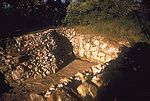 |
Pipestone Pipestone, Minnesota As of the census of 2000, there were 4,280 people, 1,900 households, and 1,138 families residing in the city. The population density was 1,090.8 people per square mile . There were 2,097 housing units at an average density of 534.4 per square mile... 44.013333°N 96.325278°W |
Pipestone Pipestone County, Minnesota As of the census of 2000, there were 9,895 people, 4,069 households, and 2,726 families residing in the county. The population density was 21 people per square mile . There were 4,434 housing units at an average density of 10 per square mile... |
Pipestone National Monument preserves traditional catlinite Catlinite Catlinite is a type of argillite , usually brownish-red in color, which occurs in a matrix of Sioux quartzite. Because it is fine-grained and easily worked, it is prized by Native Americans for use in making sacred pipes such as calumets and chanunpas... quarries Quarry A quarry is a type of open-pit mine from which rock or minerals are extracted. Quarries are generally used for extracting building materials, such as dimension stone, construction aggregate, riprap, sand, and gravel. They are often collocated with concrete and asphalt plants due to the requirement... just north of Pipestone, Minnesota Pipestone, Minnesota As of the census of 2000, there were 4,280 people, 1,900 households, and 1,138 families residing in the city. The population density was 1,090.8 people per square mile . There were 2,097 housing units at an average density of 534.4 per square mile... . The catlinite, or "pipestone", was and is used to make peace pipes, vitally important to traditional Plains Indian Plains Indians The Plains Indians are the Indigenous peoples who live on the plains and rolling hills of the Great Plains of North America. Their colorful equestrian culture and resistance to White domination have made the Plains Indians an archetype in literature and art for American Indians everywhere.Plains... culture. The quarries are sacred to the Dakota Sioux (Lakota) Native American Native Americans in the United States Native Americans in the United States are the indigenous peoples in North America within the boundaries of the present-day continental United States, parts of Alaska, and the island state of Hawaii. They are composed of numerous, distinct tribes, states, and ethnic groups, many of which survive as... s, and were neutral territory where all tribes could quarry stone for ceremonial pipes. |
Minnesota historic sites
The Minnesota Historical SocietyMinnesota Historical Society
The Minnesota Historical Society is a private, non-profit educational and cultural institution dedicated to preserving the history of the U.S. state of Minnesota. It was founded by the territorial legislature in 1849, almost a decade before statehood. The Society is named in the Minnesota...
, a private, non-profit educational and cultural institution dedicated to preserving the history of the state of Minnesota
Minnesota
Minnesota is a U.S. state located in the Midwestern United States. The twelfth largest state of the U.S., it is the twenty-first most populous, with 5.3 million residents. Minnesota was carved out of the eastern half of the Minnesota Territory and admitted to the Union as the thirty-second state...
, owns and operates 26 museum
Museum
A museum is an institution that cares for a collection of artifacts and other objects of scientific, artistic, cultural, or historical importance and makes them available for public viewing through exhibits that may be permanent or temporary. Most large museums are located in major cities...
s and historic sites. Most, but not all of these are National Historic Landmarks or listed on the National Register of Historic Places
National Register of Historic Places
The National Register of Historic Places is the United States government's official list of districts, sites, buildings, structures, and objects deemed worthy of preservation...
.
See also
- List of U.S. National Historic Landmarks by state
- List of Registered Historic Places in Minnesota
- Historic preservationHistoric preservationHistoric preservation is an endeavor that seeks to preserve, conserve and protect buildings, objects, landscapes or other artifacts of historical significance...
- National Register of Historic PlacesNational Register of Historic PlacesThe National Register of Historic Places is the United States government's official list of districts, sites, buildings, structures, and objects deemed worthy of preservation...
- History of MinnesotaHistory of MinnesotaThe history of the U.S. state of Minnesota is shaped by its original Native American residents, European exploration and settlement, and the emergence of industries made possible by the state's natural resources. Minnesota achieved prominence through fur trading, logging, and farming, and later...
External links
- National Historic Landmark Program at the National Park ServiceNational Park ServiceThe National Park Service is the U.S. federal agency that manages all national parks, many national monuments, and other conservation and historical properties with various title designations...
- Lists of National Historic Landmarks

